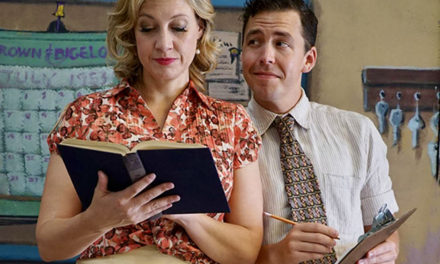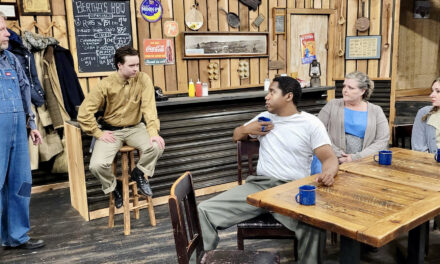I know people who believe in ghosts but don’t believe in themselves. It’s kind of sad. Okay you don’t think you’ll ever make it as a musician, but last night you saw a translucent caveman. — Mitch Hedberg, American comedian (1968-2005)
By Kelly Oristano
The Thin Place, written by Lucas Hnath and directed by John Schmor, is Oregon Contemporary Theatre’s most spirited contribution to the “spooky season” in recent years. Its equal parts of verbal sparring comedy, skeptical humanist ghost story, inventive staging, and smartly calibrated performances swirl and dance around each other to create an engrossing tale that explores the relationship between the living, and the people who have gone one step past that.
Our central character Hilda (Erica Towe), who’s on stage every second of the 90-minute runtime, is a young woman who has experienced painful loss and been left vulnerable by the trauma. Hilda is also tasked with the lion’s share of exposition as she’s alone up there for the first 10 minutes telling us everything about how and why she came to the exact spot in which she finds herself, and the confluence of events that led her to meet Linda.
Linda (Trish DeBaun) is a medium, though she might prefer the term spiritualist. Hilda attends one of Linda’s salons and eventually gets the chance to “talk” to her favorite departed relative, a grandma who had lived with her for a time. While the contact from beyond is jarring for Hilda, it’s also exactly what she thought she wanted, and she quickly becomes an acolyte to Linda. They become fast friends, and Hilda enters Linda’s social circle.
That circle consists of Sylvia (Vanessa Greenway,) Linda’s wealthy patron and probable source of Linda’s rent, and Jerry (Cloud Pemble,) her “cousin” who helped her solve some recent visa issues. These characters share less stage time but nonetheless flesh out the world in huge ways. Left with only Hilda and Linda, the tale could be unfolding anywhere in the United States. Sylvia and Jerry give a defining sense of place, class, views, and manner to the world these people inhabit.
Hnath has a specific primary meaning for the term “thin place.” It definitely refers to the transitional dimension of the classic “unfinished business” ghost. But, at least in this staging, Hilda’s world is rife with “thin places.” Losing your gran and mom within a year is a “thin place.” Realizing you might have been credulous to a fraudster is a “thin place.” Being the only middle-class person in a room full of wealthy people is a “thin place,” as is the only progressive in a room full of moderates or the only Englishwoman in a roomful of Americans. “Thin places” stack upon themselves, further breaking down the boundary between the living and the not.
Linda and Hilda become close enough over time to have genuine conflict. Linda does not like to use her “gift/affliction” outside the salons, and Hilda grows more insistent to reconnect with her gran until a breach occurs between the women. This breach is the real meat of the play, and it’s delightful to see it fall apart in front of you in the hands of these two fantastic actors.
It wouldn’t do to get into more specifics here. Instead, here are some general propositions about ghost stories: The best ghost stories end with a question mark. If your ghost story ends with “it was a ghost,” then the rationalists in your audience won’t accept it. If your ghost story ends with “it was just a trick,” then you’re doing a Scooby-Doo*, and it loses the liminal skin-tingling vibe of a great ghost story. But if you can straddle that line perfectly, you can leave everyone in the audience with the discomfiting sensation that a ghost story means to impart.
To the extent that this play ends with a question mark, I liked it and it was well executed. But it also ends with a bit of a trick, and I must confess I want to know why. Why did Hnath write it that way and why did Schmor stage it that way? I suppose the fact that I’m still pondering it means it was a bit more effective than a simple Scooby-Doo.
Erica Towe is marvelous as Hilda. She’s always an engaging lead, but The Thin Place lets her show some of the best colors in her palette, and she moves the show ever forward with urgency and want. Trish DeBaun, making her OCT debut, is forceful and funny as a spiritualist, and gives vibrant weight to the human character, herself caught in countless “thin places.”
Cloud Pemble finds humanity and dynamism in a character that could have been reduced to smarmy mansplaining, and Vanessa Greenway is delightful and whip smart as the most skeptical voice in the show (a voice my inner voice was loudly agreeing with throughout).
John Schmor’s staging is both bare bones minimal and at moments almost aggressive. As Hnath explores the porous boundary between Alive/Not, Schmor loves to play with the boundary between The Show/Not. So no light cue announces the start of the show —Hilda just walks in, sits down, and starts. The house lights remain on well past her opening monologue. Later, some important scenes happen in total or near-total darkness. There’s no set to speak of, just the simple “black box” that is OCT’s theater space, with two comfy chairs and a small end table.
But Schmor’s creativity, Erin Wills’ character-defining wardrobe, and Riley Allen’s light design manifest a whole world out of that black box.
In sum, a strong, smart, seasonal suggestion. Spooky, simple, and superlative.
*Scooby Doo — English rhyming slang for “I don’t have a clue,” used in the sense of something that helps to solve a problem or unravel a mystery; later used as the name for a popular cartoon dog in a television series of that name that ran from 1969 to 1986.
The Thin Place continues at Oregon Contemporary Theatre
When: Evenings at 7:30 p.m. on Oct. 26-28, and Nov. 2-4; 2 p.m. matinees on Oct. 29 and Nov. 5
Where: Oregon Contemporary Theatre, 194 W. Broadway, Eugene
Tickets: $25/$39/$49, available online at octheatre.org or at the box office, 541-465-1506 (see website for hours); $20 for students with current ID
Information: 541-465-1506 or octheatre.org












